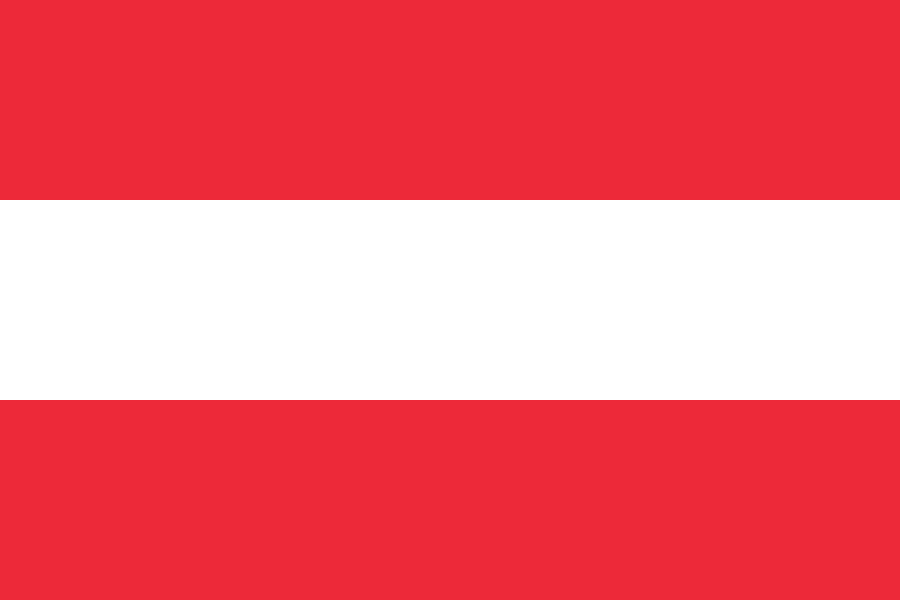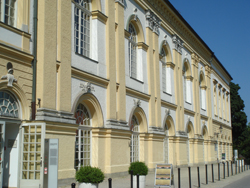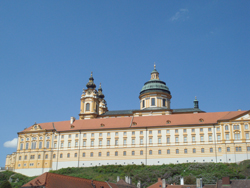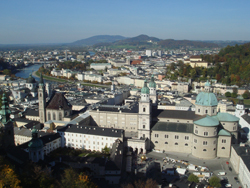 Acclaimed
as one of the most beautiful Baroque style cities in
Europe,
Salzburg
oozes the history and significance of the Prince-Archbishops
who once ruled this area. There is, as a result, plenty to
keep you occupied in and around the old town. The historic
centre of Salzburg has been inscribed on the UNESCO
World Heritage list since 1996. Theres are just a few
of my selections.
Acclaimed
as one of the most beautiful Baroque style cities in
Europe,
Salzburg
oozes the history and significance of the Prince-Archbishops
who once ruled this area. There is, as a result, plenty to
keep you occupied in and around the old town. The historic
centre of Salzburg has been inscribed on the UNESCO
World Heritage list since 1996. Theres are just a few
of my selections.
-
Mozarts Geburtshaus and Getreidegasse - The Getreidegasse (Grain Lane) is a busy shopping street in the Old Town of Salzburg. Getreidegasse is probably most famous for it's old-style shop signs. Mozats Geburtshaus (at Getreidegasse 9) is where the famous Wolfgang Amadeus Mozart was born and spent the first 17 years of his life.
-
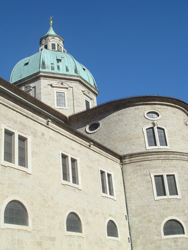 Domkirche -
Probably the most famous of the Salzburger Churches -
and not without reason. The 17th Century Baroque cathedral
boasts not only an impressive façade but one of
the elegant domes I know about. Originally to a design
by Vincent Scamozzi, hired by Wolf Dietrich, construction
actually began under Dietrichs successor Markus Sitticus
von Hohenems under whom Santino Solari fundamentally
changed Scamozzis plans. The present Cathedral is, partially
at least, built on the foundations of the old basilica
and foundations stones of the preceding church are visible
in Domgrabungen - an excavation site under the Cathedral
which also shows artifacts when from when this was the
forum of the Roman city Juvavum.
Domkirche -
Probably the most famous of the Salzburger Churches -
and not without reason. The 17th Century Baroque cathedral
boasts not only an impressive façade but one of
the elegant domes I know about. Originally to a design
by Vincent Scamozzi, hired by Wolf Dietrich, construction
actually began under Dietrichs successor Markus Sitticus
von Hohenems under whom Santino Solari fundamentally
changed Scamozzis plans. The present Cathedral is, partially
at least, built on the foundations of the old basilica
and foundations stones of the preceding church are visible
in Domgrabungen - an excavation site under the Cathedral
which also shows artifacts when from when this was the
forum of the Roman city Juvavum. -
Collegiate Church - The Collegiate Church was designed by Fischer von Erlach between 1694 and 1707, the Church was originally part of the Benedictine University. Disbanded in 1810, the Church was reopened in 1962 as part of the University of Salzburg. The convex façade is impressive and juts out like a giant bay window. The high altar by Anton Pfaffinger dates from 1740 and includes classical-style columns which represent the Seven Pillars of Wisdom and altar paintings by Johann Michael Rottmayr. There's a regular market in the square which surrounds the Collegiate Church.
-
Fransiscan Church - The Fransiscan Church is a wonderful church to visit becuase of its mix of architectural styles. Construction began in the 8th century and the evolution of the interior wasn't finished for several hundred years. The nave, in the Romanesque style, Gothic choir with ornate ribbed vaulting and nine baroque chapels by Fischer von Erlach span several hundred years of development and architectural styles. The church was renovated in the neo-Gothic style in 1866.
-
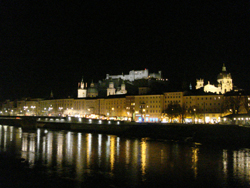 Hohensalzburg
Fortress - Imperiously situated on the Monchsberg
above the Salzburger Old Town, the Hohensalzburg
is one of the most dominating features of the Salzburg
skyline. Home to several museums, the fortress is
worth a visit purely for the vistas alone.
Hohensalzburg
Fortress - Imperiously situated on the Monchsberg
above the Salzburger Old Town, the Hohensalzburg
is one of the most dominating features of the Salzburg
skyline. Home to several museums, the fortress is
worth a visit purely for the vistas alone. -
Schloss Hellbrunn - Early baroque palace constructed between 1613-19 by Markus Sittikus von Hohenems − the rather cheeky Prince-Archbishop of Salzburg who conceived the "Watergames" or joke fountains, designed to squirt water at unsuspecting guests, which adorn the gardens of the Schloss. There's no bedroom at Schloss Hellbrunn which was designed as a day residence of the Prince-Archbishop who would return to Salzburg in the evenings.
-
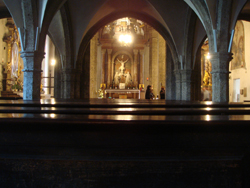 Church
of St Blasius - which was originally constructed
for the peoples hospital in 1327 and consecrated in
1350. The rather dark Gothic / Romanesque Church also
boasts some Baroque elements. Of particular note are
the tabernacle which dates from 1481, and an altarpiece
by Paul Trodger dating from 1746 depicting the adoration
of the Magi. The High Altar is after a design by Louis
Grenler and dates from 1785 and the cruicifixion grouping
is by Franz Hitzl. The stained glass dates from 1947/8
is from Albert Birkle
Church
of St Blasius - which was originally constructed
for the peoples hospital in 1327 and consecrated in
1350. The rather dark Gothic / Romanesque Church also
boasts some Baroque elements. Of particular note are
the tabernacle which dates from 1481, and an altarpiece
by Paul Trodger dating from 1746 depicting the adoration
of the Magi. The High Altar is after a design by Louis
Grenler and dates from 1785 and the cruicifixion grouping
is by Franz Hitzl. The stained glass dates from 1947/8
is from Albert Birkle -
Greek Catholic Church of St Mark - In Gstatteng, alongside a row of houses which have been hollowed into the sheer cliff face of the Monchsberg - the Greek Catholic Church of St Mark boasts an elaborate interior. Church is well lit by windows surrounding the dome above a Greek cross.
-
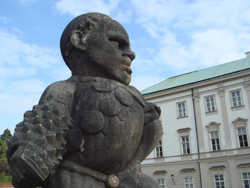 Schloss
Mirabell and the Dwarf Park - The Schloss
Mirabell - now offices of the mayor and the municipal
councile - is famed for its Marble hall and Baroque
staircase (which can be visited during the week)
but is now mostly off-limits to the public. Schloss
Mirabell is, however, surrounded by some beautiful
gardens laid out under Prince-Archbishop Johann Ernst
Graf von Thun to the design by (unsurprisingly) Fischer
von Erlach and were remodelled by Franz Anton Danreiter
in 1730.
Schloss
Mirabell and the Dwarf Park - The Schloss
Mirabell - now offices of the mayor and the municipal
councile - is famed for its Marble hall and Baroque
staircase (which can be visited during the week)
but is now mostly off-limits to the public. Schloss
Mirabell is, however, surrounded by some beautiful
gardens laid out under Prince-Archbishop Johann Ernst
Graf von Thun to the design by (unsurprisingly) Fischer
von Erlach and were remodelled by Franz Anton Danreiter
in 1730. -
St Sebastian Church and Cemetary - A short walk from the Schloss Mirabell is the St Sebastian Church and its cemetary. The Church, somewhat restrained in its Baroqueness, is outclassed by its fascinating cemetary with assorted "celebrities" buried therein. Leopold Mozart, Wolfgangs father, is burried alongside Constanze Weber (Wolfgangs wife) who, in turn, is buried alongside her second husband. Cardinal Wolf Dieter - one time Prince-Archbishop of Salzburg is emtombed, quite ostentatiously, is a grand mausoleum in the centre of the graveyard. The selfstyled Paracelsus is also buried with an elborate headstone at the church-end of the cemetary. Keep an eye out for the skulls which decorate many of the tombstones.
-
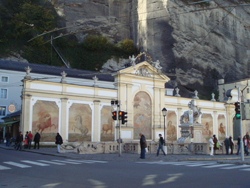 Horse
wells (Pferdeschwemme) - I'm not normally one to
mention horse troughs - but the ones in Salzburg are
worth it. Usually in full Baroque style trough with
paintings and depicting horses in a variety of poses
and scenes - the one pictured is in the old town and
there's another adjacent to the Cathedral. Now, of
course, they serve no particular purpose other than
the purely decorative - some like to toss coins in
but thats not the same as Trevi.
Horse
wells (Pferdeschwemme) - I'm not normally one to
mention horse troughs - but the ones in Salzburg are
worth it. Usually in full Baroque style trough with
paintings and depicting horses in a variety of poses
and scenes - the one pictured is in the old town and
there's another adjacent to the Cathedral. Now, of
course, they serve no particular purpose other than
the purely decorative - some like to toss coins in
but thats not the same as Trevi. -
Markets - A flea market is held in the courtyard of the Speilzeugmuseum and a food market outside the Collegial Church - both of which are worth visiting for nick-nacks and fine samples of local produce. On our last visit to Salzburg, we picked up some excellent Kirsch from Schroffenbrennerei Grödig from the food market at the Collegial Church. There's also a regular Christmas Markets in Salzburgs Old Town.
